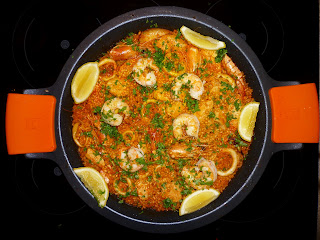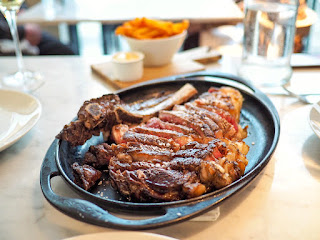 |
| Paella with chicken, prawns and squid in my sexy paella pan |
I have a lot of cookbooks. Thankfully, I don't buy as many as I used to as I finally realised I've got no space for them. When we moved recently, I purged the ones I found I rarely cooked from and left them in the foyer of the apartment building I lived in. They all disappeared in an afternoon. It goes to show that people still love to cook. Or just like a freebie.
These days, I generally only buy books from authors I really like or on recommendations from friends or if I have a special interest in a certain type of food. That's why I asked for Paella by Alberto Herraiz for my recent birthday (I urge you to get it here:
http://www.amazon.co.uk/). I love rice and I love Spanish food so I thought the book would be perfect. The design is also pretty cool, like all the Phaidon cookbooks these days.
I've cooked a few paellas before, mainly from the Moro cookbooks (
http://www.moro.co.uk) and generally these are great. I actually bought a proper paella pan last time I was in Barcelona (endorsed by the legendary chef Martín Berasategui...check it out here
http://www.braisogona.com/ and don't you love the removable ovenproof orange handles?). This replaced a cheap one I bought in Valencia, funnily enough on a post-paella high, which lasted one use before it rusted. We live and learn - sometimes you get what you pay for.
 |
| Step 1: start the fumet |
Since it's been such cold weather here in London recently, we hunkered down one weekend and cooked and baked. I decided my first paella from the book would be chicken, king prawns and squid. It was a pretty straight forward recipe, but there were a couple extra things to make before getting the rice into the dish. First, you need to make a stock, or a shellfish fumet, and also a tomato sofrito. For the fumet, we grabbed a kilo of prawns for their heads and shells and kept some of the prawn meat for cooking in the paella later on. We saved the rest and had them the next day, tapa-style in little ceramic dishes, baked in the oven with garlic and chilli and lots of lovely Spanish olive oil mopped up with some crunchy bread. The fumet was full of good things like celery, carrots, leeks, tomatoes and prawn heads. Unusually, it also included some lemongrass and lime zest to finish it off. The soffrito had similar base ingredients to the fumet, along with a can of tomatoes which is simmered for an hour or so to intensify the flavours. While these two steps took a bit of time, I've now got lots in the freezer for an easy mid-week paella. I'd also say skip the suggested shortcuts of just using passata in place of the sofrito and fish stock instead of making the fumet.
 |
| Step 2: cook the sofrito and the fumet |
On to the cooking of the paella. The shelled prawns are first flash fried in some garlic and removed to be added at the end. The chicken quickly follows to brown before some prawn heads (for more flavour) and the squid rings go in. The rice is next to coat in the infused juices before adding some of the sofrito and then the fumet. This is when the cooking of the paella deviates from what I'm used to with the familiar Moro recipes. The dish is cooked at a high simmer for exactly 5 minutes before going into a 150 degree oven for 12 minutes. I was sceptical, but this was actually enough time for the stock to be absorbed and the wonderful
soccaret to form - the crunchy, crusty, caramelised base of the paella. I added the earlier fried prawns, covered the pan with foil and three minutes later, dinner was ready. You can take the prawn heads out or serve them for those who like a little something juicy to suck on. All the dish needed was a little parsley and some lemon wedges. I have to proudly admit, the result was quite spectacular, and looked the biz too thanks to my pan.
So check out the book if you like paella. It's a great read, and based on this one recipe (OK not a big sample), Alberto knows what he's talking about and I'm looking forward to doing some more. I think the only downside to the book is that a bunch of the recipes are designed for cooking outdoors so the ingredient list is multiplied for the larger pan size. Its easy enough to just experiment with cutting this down to fit the pan you happen to be using though.
Oh that reminds me, I should definitely tell you about the Valencian paella episode.





Comments
Post a Comment